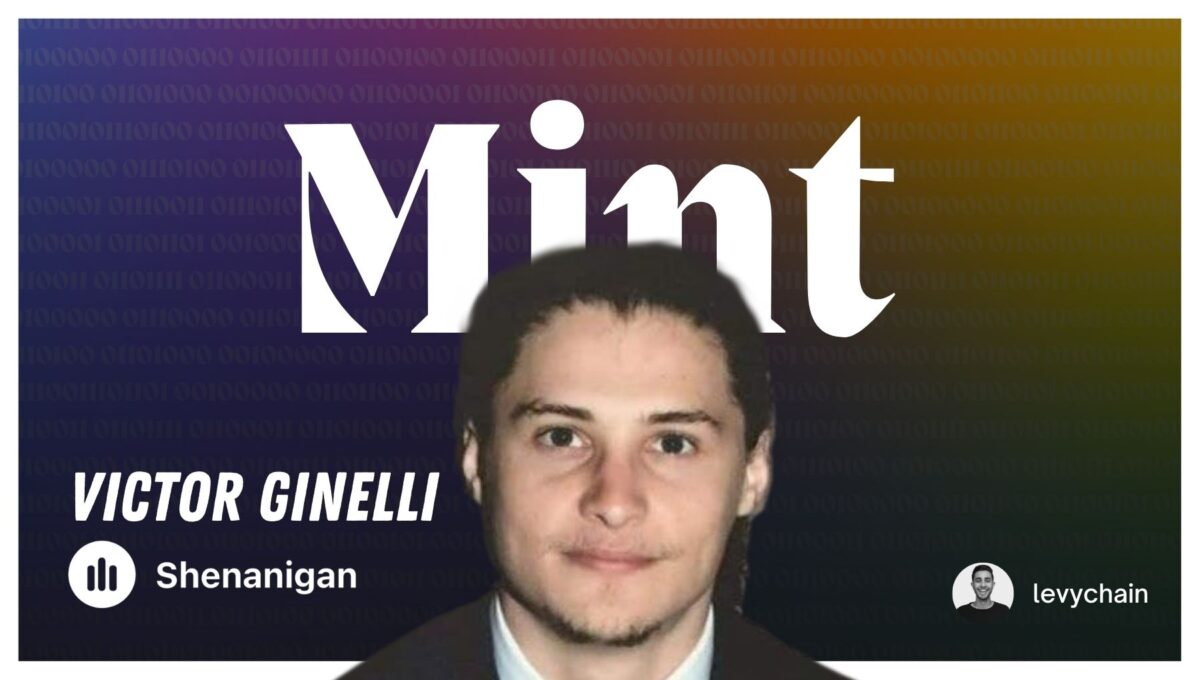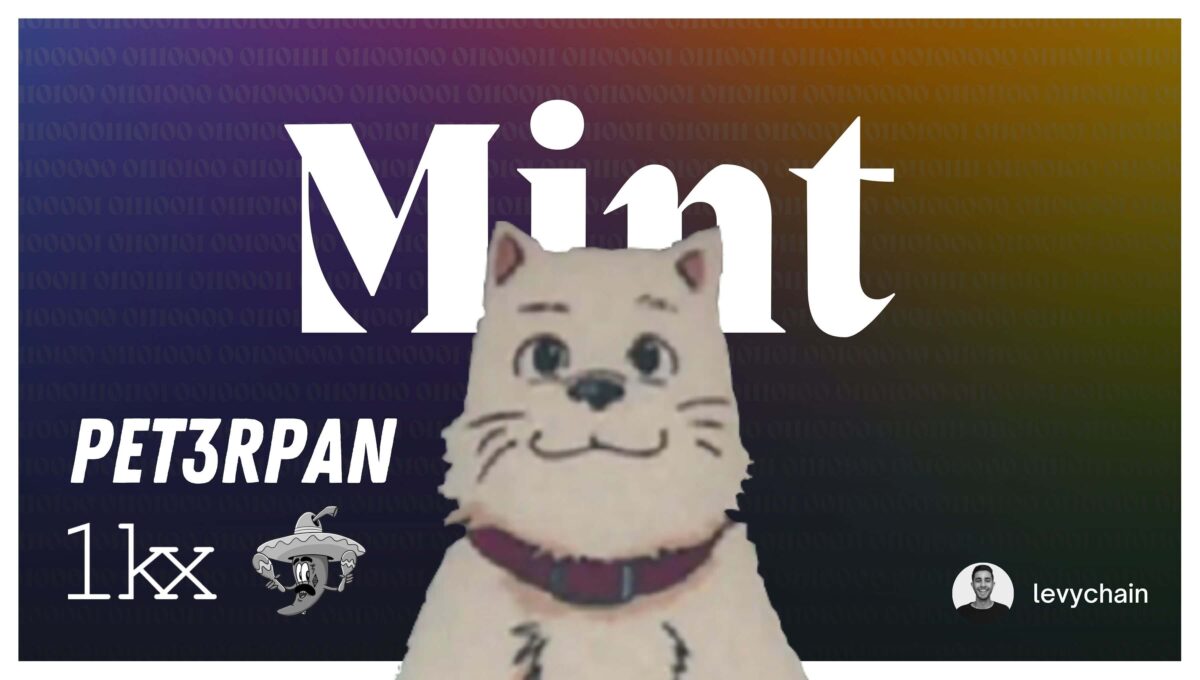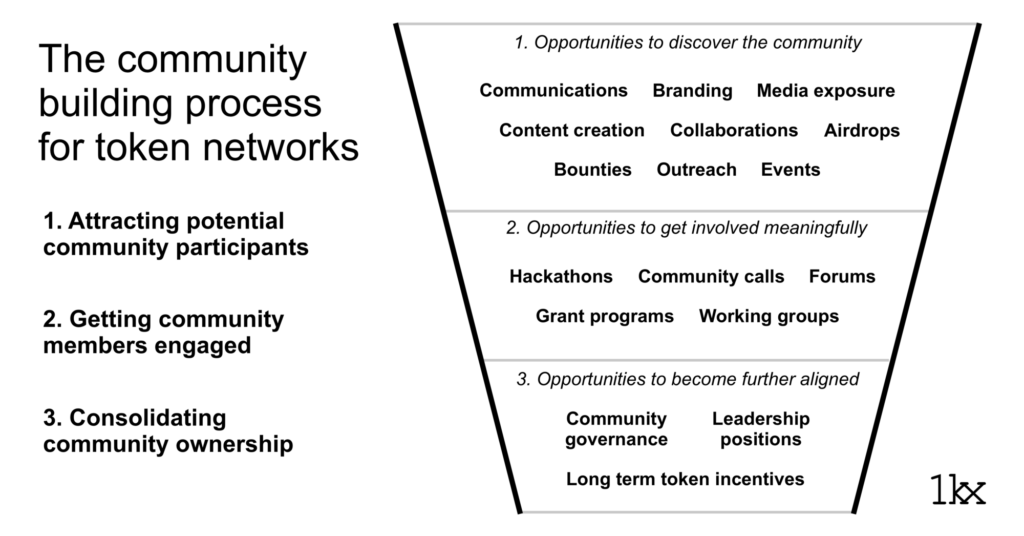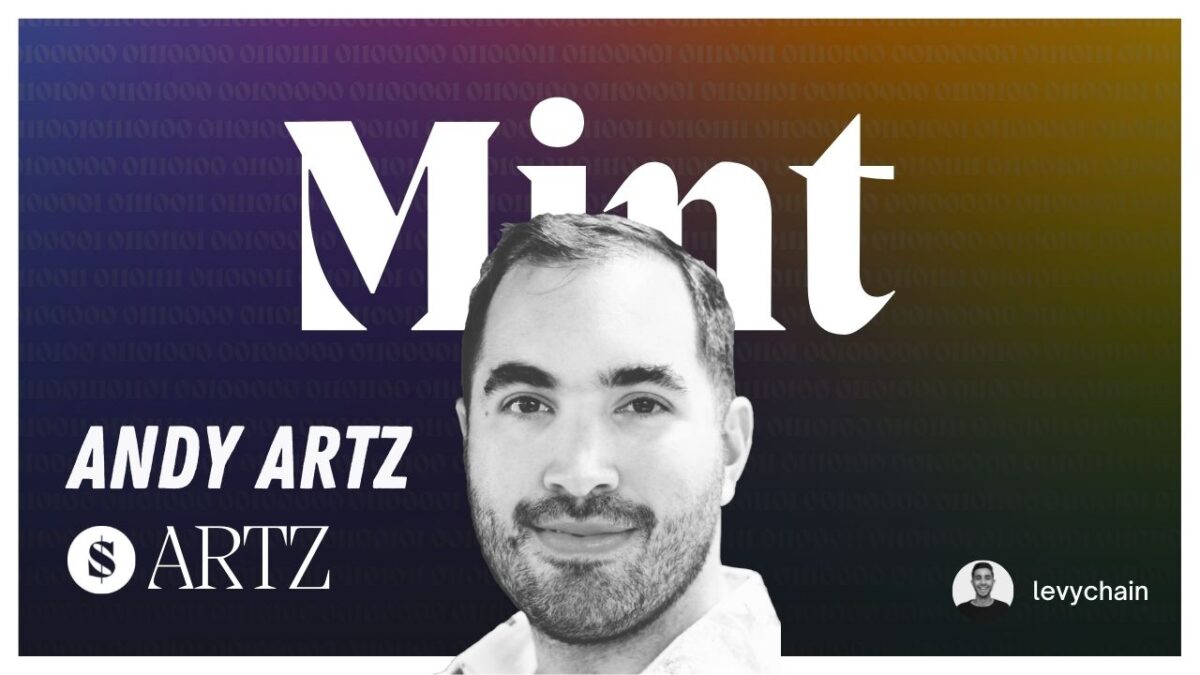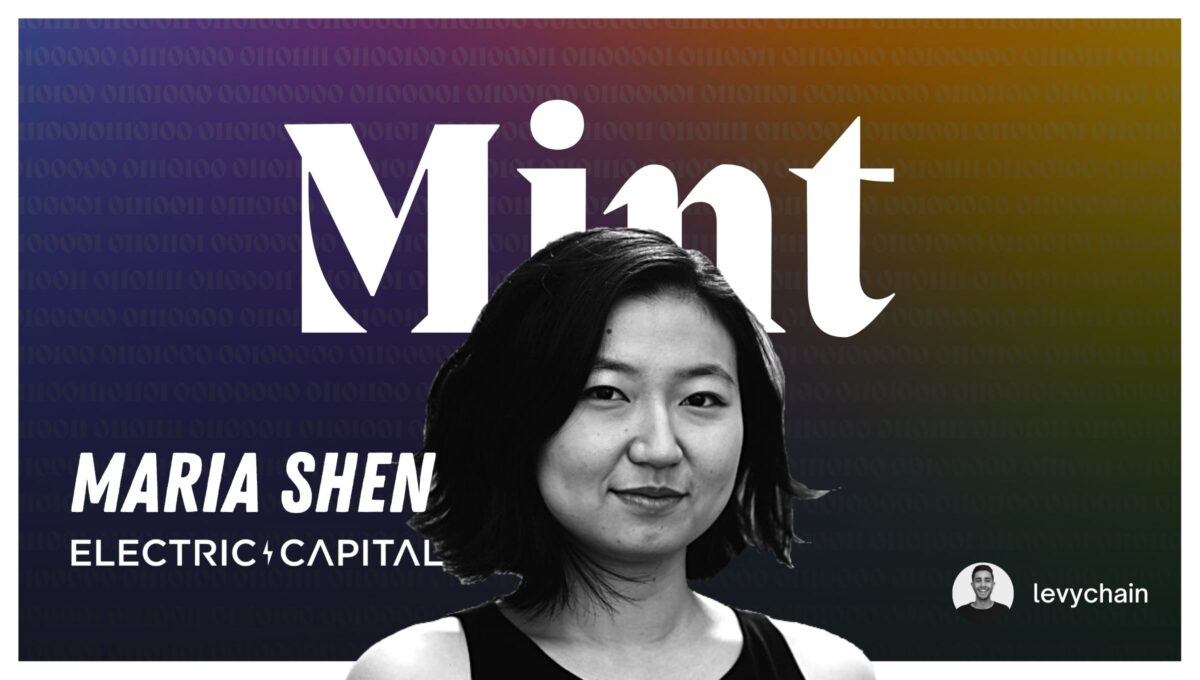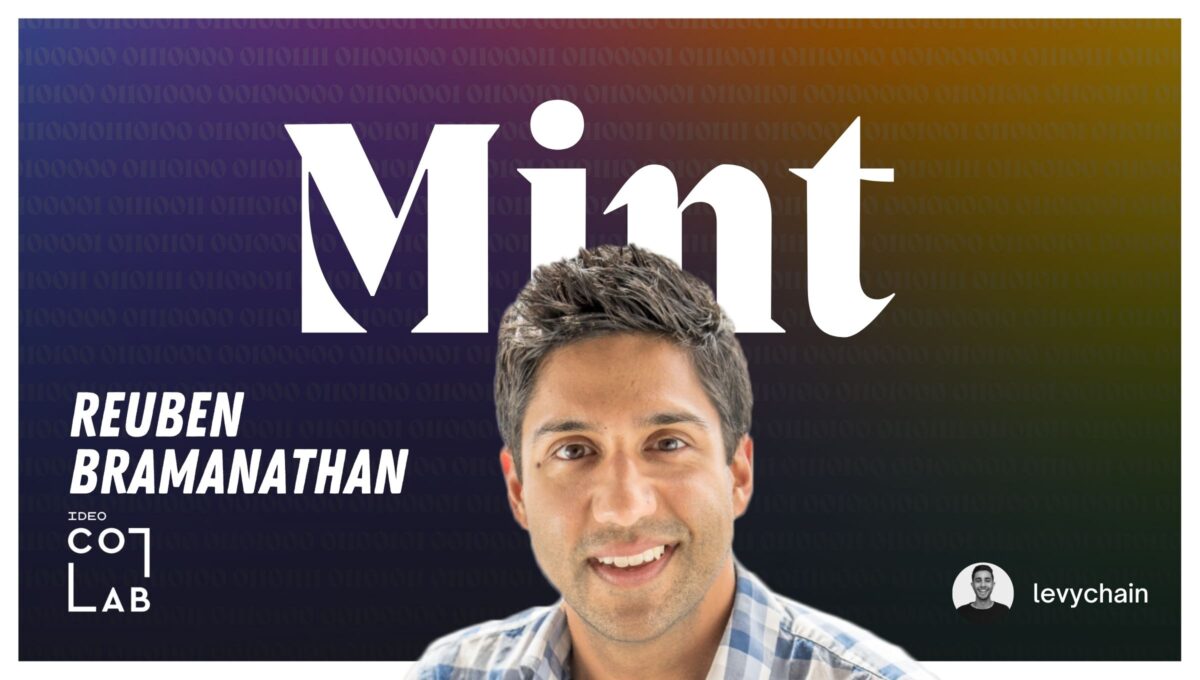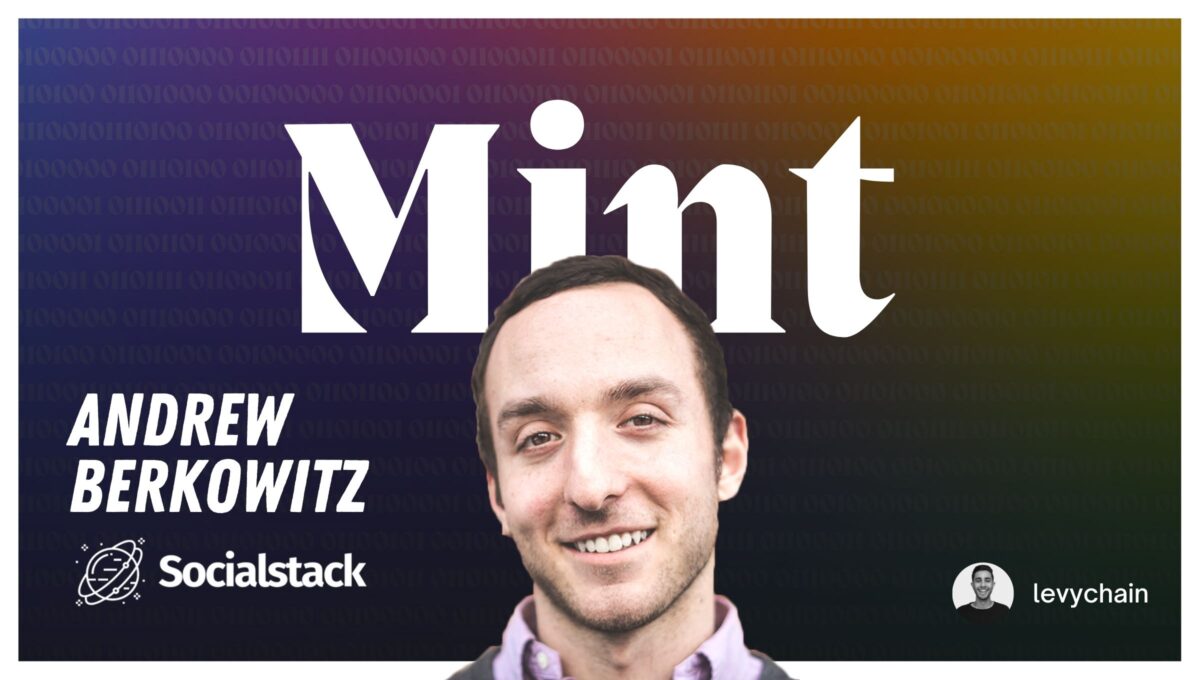Listen on: Spotify | Apple Podcast | Google Podcast
Background
Mint Season 2 episode 12 welcomes founder & Builder of Shenanigan, Victor Ginelli. Shenanigan or SHE for short, is a social token issuance platform for athletes.
In this episode, we talk about:
- 2:30 – Getting Into Crypto
- 6:02 – Building a Career Beyond Sports
- 10:26 – Shenanigan DAO
- 12:07 – Working for an Algorithm
- 16:42 – Earning Through Participation
- 20:15 – Social Tokenomics
- 26:16 – Post Mortem Social Tokens – Retroactive Earning
- 32:17 – Integrating Token Models
- 35:40 – Outro – Closing Out
Thank you to Season 2’s NFT sponsors!
1. Coinvise – https://coinvise.co/
2. POAP – https://poap.xyz/
3. Socialstack – https://socialstack.co/
4. Celo – https://celo.org/
5. PrimeDAO – https://www.prime.xyz/
Interested in becoming an NFT sponsor? Get in touch here!
Let’s start with: who are you? What are you building?
I’m Victor, young kid warrior on the coding realms, and I work and found and summoned shenanigan, which is a DAO for athletes. We believe that the internet is horribly set up for athletes. And we believe web 2.0 has kind of made it worse. So we have a great NFT social token DAO model. Where we set these athletes up, that is slowly in development.
How long have you been working on SHE?
It’s been about a year and a half now. My personal, you know, it gets a little muddled. Like I kind of picked it up, put it down. I always wanted to help people incentivize themselves over the internet. Clicks, likes views, just don’t quite do it for me. I want to touch what they actually achieve. And I think really that’s what people like gravitate to. Yeah, you can check us out and she.energy, that’s our website. Join our discord. The app will be launching in three to five months. We just had this huge decentralized restructuring. We started decentralized, but with the space of web 3.0 tech that’s come out in the last year, it’s just going to be revolutionizing how data is stored. And how data is retrieved from the blockchain. And we want to be caught up, so we did this restructuring. And then from there, it’s onto what we want to talk about today.
What were you doing before crypto and how did you kind of make your way into it?
Yeah. Let’s start from a little bit back into the college years. I was an athlete. I was a competitive diver. You see me here. Like 220, 6 foot, no one ever believes that I was a diver. First thoughts, like, you’re a rugby player right? I did flips, jumped off high shit and landed in water. And so from there I graduated with a physics computer science degree. And basically taught for two years while I developed, you know, apps on the side. Got a job at a small startup called rain. Five months later, the pandemic hit pretty much worked on the blockchain full-time right after that, I said, you know what, I’m gonna be at home all day, I might as well get into crypto full-time as a developer. I had known about it probably since 2017. I bought my first ETH at like $80 and then a big dip before it went to 200 and then back down and now, yeah.
So you got started by buying some Ethereum, but how did you get so obsessed with the creator side of things? Because Shenanigans is reimagining monetization for a specific class of creators, or we can categorize them as creators, but they’re athletes. I get the athlete portion, but how did you get into the social token and NFT route?
You know, it’s a cliche that, I’m in it for the tech. I’ve always been in it for the tech. I heard about DAOs really early on. You know, I was a developer, so most of the time I spent just reading medium articles and not really talking to people at the beginning. And I was like, this is going to change everything, dude. Like the structures you can build for society is just huge. So that got me really interested in what does a company look like on the blockchain? And then that got me interested in, okay, well what does the code look like? What can I build to utilize these new companies on the blockchain? And I kind of didn’t have anything. I didn’t know what to build. And I was just like new developer budding three years ago. Not new, but not seasoned. Woke up one morning, didn’t want to get out of bed. And it was like, knowing if someone else had money on me doing this, if I had investors it would get me out of bed. I didn’t do it. But if I had money on myself, I would not. I would just stay in bed all day, but I realized that’s a great incentivization model. It’s like, well, if you have fans and you have someone else’s money on you or invested in you, you’re going to want to do a lot more. And that’s actually what athletes do right now. So it’s just a way to get me out of bed originally.
Interesting. So what’s your motivation as an individual?
Well, as an athlete, I’ve experienced what it’s like trying to make it past 18. You know, everyone does a sport, almost everyone for 18 years of their life and they work almost a full-time job. And then they have nothing to show for it. It’s you know, great mental fortitude, great job, now you’re gonna go pack boxes at home Depot. Or you’re gonna work at a desk job. So my motivation is like, I’ve been there. I’ve done that. And I want to incentivize people to make it pass where I did, which was college. Monetize yourself and improve at the same time. It was probably the main thing.
Adam: So the argument here is, the reality is like people go from high school into college sports, whether it’s D1 D2, and they’re able to build really good university careers for them. And like the percentage of transfers from high school to college is already slim. And then from college to like the professional leagues is even slimmer. And when you’re an athlete in college, like you said, it’s a full-time job. And you’re taking classes you have to pass and do your shit. But like you’re betting on yourself and betting on you kind of going to that next level beyond college. At least a lot of sports people are right. A lot of athletes are.
So you’re coming from the point of view, like, whether you’re a college athlete, whether you’re a collegiate D1 or a D2, or playing in the major leagues, then this social token route is for you. And the reason is, why?
Well, the reason is like, as an athlete, you don’t start making money until you get sponsored. There’s no structure for people to invest early in on you. Your parents paid for private practice, especially as a college athlete, especially as you have to pay for school, you know, unless you are signed in to a D one as a scholarship, which you know is great, but you’re essentially as a slave to a scholarship. And you don’t own that money, like you get injured, it’s over. And really what social tokens allow for is you to well social tokens and shenanigan platform, I should say, because I think there’s a lot more to this for athletes, but social tokens are a part of it, is make your own athletic journey on the blockchain with results and, structure it however you want. And however, your life pans out. If you have a community that supports you, it doesn’t matter if you’re injured and recovering. It doesn’t matter if you change sports. It doesn’t matter if you go on to be the next Elon Musk, and you just did sports in high school, or you did professional athleticism beforehand, right? It allows for a much more particular atomic granular support system where it’s not like, “Hey, you can dribble a basketball, let me make you a walking billboard”.
You know, the most recent example that comes to mind with an athlete messing around with social tokens. And we were talking about this before the recording, is that UCLA basketball player, who’s also a vlogger, who also has like 220,000 subscribers on YouTube and just launched $JROCK. Right. Let me pull up his name real quick. I’m blanking out. Jaylen Clark and I’m pulling it up over here, so UCLA basketball player Jaylen Clark is releasing his own cryptocurrency called $JROCK. I’m reading this from the LA times. He is a type of individual who is like a part-time creator and part-time athlete. All of his content on YouTube is him being an athlete.
Do you think that these athletic creators need to pivot more into the vlogging route, the TikTok route, like building up that huge, hardcore fan base for this thing to work or could it work with a micro-fan base too?
Well, what I really hate, and I think that’s what I’m fighting, is we don’t want athletes going the entertainment route. Because very few athletes can do it. And it’s not built for athletes. It’s still for entertainers. You know, some people are really good entertainers and they can do both. But I really think that we should build incentive mechanisms to focus on improving what they’re already doing. Like Focus on what will make them better. What are their goals? Athletics is all . About setting goals, achieving a goal, and going to the next one, right? That’s a great model. Why are we using, you know, these web 2.0, Tik Tok Instagram when we have such a great power with web 3.0 and like earning themselves by proving themselves every day. And we’re still early on in this social token stuff, and this is definitely a huge step in the right direction. All the power to this. Like, this is cool. We have to innovate, we have to try.
But you’re imagining it from a different angle.
I think the future is bright for athletes on the internet, especially with Shenanigan.
Shameless plug. So you talked about something behind the scenses, and you just plugged it. And I’ll sum it up as working for an algorithm. But you added more flavor, more context to it. And this is something, again, we talked about behind the scenes, which is why I wanted to have this conversation. Because it was a new concept, I came across how it works right now, across many platforms, there is no right or wrong way to do this, right? Everybody’s just throwing shit at the fan and seeing what sticks. I want to highlight this model because it’s a little bit different. And the way it works currently is you can mint a certain amount of tokens. Typically it’s 10 million tokens, that sit in a wallet with a multi-sig. And creators allocate funds to their fans, create utility around that, whatever it may be. But you’re approaching it kind of from a different angle. You’re talking about working for an algorithm and based off that,- I don’t want to butcher it. What’s the other side?
You did a great job, you know. It’s funny that you’re talking about working for an algorithm because people think algorithms are this almost static unchanging, you know, input, output. But I think really, what I imagine for these social tokens is this malleable ever-growing algorithm that changes based on what you’re putting out. It’s not just one piece of code that does the same thing. It’s like we have to plug in sports athletes to this algorithm, and then an artist app algorithm. And actually like we can even go deeper, maybe a sculptor would go into this algorithm and then a music artist would go into this. Creating an algorithm that’s customizable to the person is really what we’re doing or what I’m imagining.
So, let’s talk about an example. So I’m imagining this: people working for an algorithm get rewarded based on their actions. So you have to determine what that action is and do it in a way where you can verify that action, which then triggers the smart contract to mint an x amount of tokens.
Let me give an example of what we’re talking about, what’s kind of happening in the current space, and what would it look like? So, I think the big thing, like red herring or whatever you want to call it with social tokens, is the rug pull ability. It’s not a real word, but the rug pull. If we mint 10,000, 100,000 Adam tokens, what’s stopping Adam who controls them all from just saying “You know what, I made $20,000. I’m good. I just want to pull it all out and just dump”.
Nothing. Like technically my incentive is to not do that because I’ll fuck up my personal brand. But the reality is like, things are in place for it to happen. And it may be beyond my control too. Someone might hack and dump on top. So a hundred percent.
Right and in the world we live in, people could flip that into an entire business. So just pump it, dump it and then start another token. And I’m sure they would. And you have vesting. I hate vesting with a passion. And like, I think everyone kind of hates vesting with a passion. Sorry, if you like vesting. You should be able to do what you want with the tokens you earn and like putting it behind like a static time wall does not create much movement. It doesn’t create any like opportunity for adjustment, movement, change. It’s so boring. It’s a start though. What would be really cool, is instead of mentioning all of them at once. We start at zero. And we grow the brand over time. As the athlete or the markets or the social influencer grows, the token should grow with them.
Let’s pause right there. And that’s a very goal-driven approach. And that goes back to actually what you’re talking about earlier, like athletes, set goals, athletes, set milestones. And a lot of us operate like that. That’s like human nature to an extent, at least certain types of individuals. Okay, continue. I’m just reflecting.
It’s easy with athletes, right? And I think the reason why it’s easier to think about, and I want to structure this kind of conversation around athletes probably, is in the case of athletes, the athlete is the product. You can’t really get around that the physical human being is the product that they sell. So when you set the goal, the social token kind of wraps into that really well. And it falls in, like, let’s say the athlete actually goes off to become a professional NBA athlete. They don’t want to take over the NBA. We’re trying to give them a better path to get there for now. But let’s say they do that. Their social token follows them through that. So why should it not grow and move around with those things happening in their lives? Like goal-oriented, but also like social tokens will capture everything else as well. So let’s say the athlete, you know, Gets accepted to a D1 college after having one of the greatest seasons of their life. We’ll have NFTs of all the stuff you did that season. Physical proof on the blockchain, goals, bam, bam, bam. But the social token will capture everything that happens outside of that as well. So, it’s not only like, “oh, the number goes up”. It’s actually like,” Hey, I’m set to earn this token and my community is set to earn this token, and now this token just got way more valuable to earn. And you have people coming together behind this athlete. There’s like fans coming together to set it up, which gets me to my main point and I think your main point is, how do you set it to earn? You’re talking about working for an algorithm. How do you set a token up for positive incentives? I can have him be like, you know, tap this button a hundred times and then you earn a token. Probably a really bad model. But I wouldn’t think it would work well for an athlete, but maybe we can think of something like, the athlete earns a token in one way, the fans earn the token in another. The athlete has to get a goal out on the blockchain. They have to get some kind of proof. In Shenanigan, we use a live stream. And we wrap that live stream into an NFT, but let’s say we want to use live stats that we can pull from an Oracle that follows that. Or let’s say we want to use, like a blockchain game.
Any action, any contribution that can be tracked and verified is something that can be basically rewarded. That’s very much like a play-to-earn model. That’s what it is. It’s a twist to play to earn rather than gaming. And doing what Axie is doing for example, or there’s another one I’m blanking on. That’s like a real-world example right there, because you’re like mixing the physical with the digital and gamifying that entire experience. What do you call it?
We call it the meet space, to be a part of the Ethereum. Be a part of the smart contracts. Getting the things we do in real life to be immutably stored, retroactively searchable on the blockchain where they can never go away, it’s part history, is the goal. And I think for example, when we’re drawing these earning mechanisms, like you can start simple. Like, “Hey, we want to keep the athlete with 50% of the supply of the token”. Let’s just start with that. As he or she does the tasks at hand, the token will actually deflate until another task is minted, and then, well actually inflate, excuse me. It will inflate as the community gets it. But then the athlete will do a task and receive a reward that virtually gets it back to it’s 50%. It’s only simple like that. I should prefaced. See, this is really stuff that is still theory crap. It’s just really alpha, alpha. So coming back to the example, we keep the athlete at 50%, or you have some burning mechanism on the the community side where you say have a staking protocol and NFTs where the athlete has some sort of product in shenanigans to give them NFTs where they can stake their tokens in the NFT using a standard called ERC -998 by Nick Mudge and a couple other really smart guys. Great people, you should check it out. Staking these tokens and burning them well, they are improving their score with the athlete and giving them some DeFi rewards or, you know how it works. The opportunities could just be endless which brings me to actually another point I wanted to make. Coming back, talking about the usual blockchain historical lens. And we’re talking about working for algorithms that are ever changing and adapting. Retroactively rewarding things is what I think is so important. So social tokens and especially burn based like working for an algorithm then social tokens. We can look. Let’s say someone starts their token mints 5,000 a week. And it’s just based off of like very rudimentary metrics of like, did he put this out? Is the community buying? Boom. But let’s say down the line, an Oracle comes out or some great tech comes out or the athlete has a great idea and they want to adjust their algorithm a little bit, which you should be able to look back on all that data that already happened, and retroactively update the current percentages of each person that has tokens. And then mint tokens according to those new percentages, right. Go towards that model. So instead of having, “Hey, everything’s static, you have this much to buy more or earn more”. It’s actually like, “Hey, you have this percentage right now that you might be over or underrepresented with and we’re working towards this percentage. And as we grow your percentage changes and adapts. Does that make sense?
Yeah, it’s a lot to wrap your head around. Yeah, it’s a variable process. Right now, many social tokens are great as how they work. It’s very static. Platforms, maintain X amount or a variable amount, depending on what the standards or details of that creator are. And there’s a treasury and people try to fund that treasury with a certain amount of capital to give that token value. And this, what you’re talking about, is more dynamic. It’s way more dynamic. We’re dynamic humans, so why aren’t our token models the same? I’m trying to think, what are the pros and cons? I know what the pros are. What are the cons of doing something like that?
There are cons, right? I mean, nothing’s perfect. I think the main con is that it’s slow growing. You have to build. And of course, early on, that growth is going to be really slow. Cause no one’s done it before. And you don’t have an example of what a successful growth token looks like. We’re just starting with growth tokens or whatever you wanna call them. These like earn based economies with DAOs. Our DAO, Shenanigans, is earned based and we use it for various things inside the app. You can come by our discord and you do something for us you earn our token. We’re just starting with DAOs, and so it’s a slow growth. It’s not like minting 10,000 tokens matching it and then making millions. Just like humans, it’s got to grow. Just like who we are, it takes some dedication and it takes your time.
It’s very much a long game, right? And for creators and athletes who understand the value of building something long term, it’s going to click with them. And the issue is with retail investors and many private investors that they want to see money now. Making a bet, like a five-year, ten-year bet, a 12 year bet, seeing the development of an individual over time, especially as an athlete, there’s a lot of risks about being an athlete to begin with. Like what’s the average career length for an athlete, for example? What does that look like? It’s like 3, 5 years or something? In the sport. You know, so what happens after that? Then you start your coaching league , you know, and your incentives are based off how many people you coach and how many people you get to like the NFL. You know what I mean? Like what does that kind of look like? How does that kind of carry on beyond being an athlete? So that’s one of the cons, not a con, just like a gray area of like, what’s the answer? How do we fill that answer? So the slow growth, that’s one con. What’s another con?
I would say that’s the main con man. It’s complicated to explain maybe but, I do want to expand a little bit. When you said, like where an athlete’s career stops after, you know, five, 10 years. I don’t know if I believe that. I do think that an athlete is an athlete for the rest of the time that they are alive on this earth. It’s just how you structure your athleticism. That’s what we’re trying to change in shenanigans. It’s not about actually, if you’re a professional or not. What we’re trying to do is focus on the improvement, right? Have people invest in your improvement whether or not you are improving your field goal kicks, or you’re improving as an older athlete in a different league with your field work. You hear what I’m saying?
Yea and you know where my mind is going right now? Like, how do you track these things now? Now you’re talking about IOT sensors kind of verifying. Otherwise, you’re now relying on human judgment to kind of tell or depending if it’s like a live game or if it’s like an in practice thing, are there IOT sensors now attached to balls and goals to kind of determine which ones you missed. You know what I mean? How do you automate this? So people don’t have to constantly logging their stuff or sharing it, you know what I mean?
Yeah. There’s a lot going on in my mind about that. It probably has to do with Oracle’s and the blockchain and large systems. Like you say, IOT. Let me tell you what we do at the start of Shenanigan and how we were sharing and hosting a live stream for these athletes, right? So it’s something that can be verified with live. And then we use our DAO, which has a great version of uniqueness for the token, we use our Dao to vote on what actually happened in that live stream. And the idea is we want as many people to vote and give their opinions on what actually happened for these very simple, rudimentary questions. Did the field goal go in between the poles? What’s a real push up? Did he do 10 pushups? Did he make the cake flip satisfying enough? And it’s kind of relying on athletes to be particular with what they want to do as well. Because if they’re like, “oh, I’m going to jump off this bridge and the water”. He does five flips? It’s like, well fine. You know what I mean? It relies on them, just being creative. You have to be very specific with what you want to do and what you’re doing. But having these like general votes of what happened on the live stream is probably, it encompasses a lot. You can do a lot with that, right? So that’s how we do that. Using the DAOs and a quadratic vote. This like flattened out vote to get as many opinions that are human certifiably unique into an NFT that says, “Hey, this is what happened at this point in time in history for this individual”. And then social token just kind of fits right in there.
Wow. So is there a capped supply on these social tokens?
So with this, think earned based, there is no capped supply. You can have a capped supply. I don’t know what’s best. My DAO shenanigan, I shouldn’t call it my DAO. The DAO I summoned has no cap at the moment. Someone told me there’s nothing wrong with inflation. Like it’s a stigma, but inflation can be very, very good. But I do know other communities like one hive or other social token communities using a static model, where they just allocate a certain amount of tokens to their distribution, to that earn base. So it can be done both ways. I don’t know what’s best for social tokens. To me, my vision and stuff that I’m working on has an infinite cap. So I’ll say that.
Which makes sense for this model, because your coin is dynamic and evolves as you grow and evolve. And with that, if you cap at 10 million, you’re like 46 years old, and you’ve reached all your milestones. Like you run out, you know, what’s next? You issue a new token? Like, no, it doesn’t make sense. What happens when the athlete dies? So let’s apply this from the Kobe point of view.
Well, speculation never ends, right? I guess. Kobe with him, it was so sudden. Like, I feel like it’s almost two different things of legacy as like, if you live all like dying old and die young, right? So with Kobe’s Example, you have this, for lack of better words, this hype, that builds rarity. Like people want his stuff because he’s no longer around and the speculation doesn’t end. It just is like, it gets rarer and rarer and rarer the older it gets. So it’s almost like you’re leaving a piece of history behind. You’re leaving your legacy behind. It’s like, I guess you’re quantifying how much your athletic career was worth to people. But instead of it being a static quantification of like, “Hey, he made $200 million playing for the Lakers”. Now there are markets for it. And like, you know, your children see that and your children’s children and you have this legacy that’s immutable. And when an athlete dies I guess like, you know, it’s tragic to people’s emotions and lock into that, like collectable kind of like, the community is still there. I know people who wear Kobe shirts everywhere.
Yeah. It’s like Queen, it’s like Freddie Mercury dying, the movie coming out around him. And like the bands meetup at the bars and like the legacy of queen continues, right. The legacy of Kobe continues. How does it tie into the speculation of a token though?
It’s interesting to think like what about undervalued athletes at a time? And then people realize, oh, they are really cool. Like they did something really cool or innovative, you know. Now when they can retroactively go back and let’s say this athlete put their stuff on the blockchain, but let’s say he was overlooked, it happens all the time. But you know, let’s say not a well-known guy innovates on like hit and swing. You can go back and say, “Hey, we have all this history, this hype, and who knows who that benefits, you know what I mean?
Could people unlock their tokens by their past achievements? If the community comes to consensus, for example? It’s like a play to earn point of view. The more milestones you hit, the more you earn, the more tokens get up and your wallet. Could he do a pitch where like, “Alright guys, like I’m already in the middle of my career, look at all the milestones I hit, will you guys allow me to receive some of my tokens in advance”? Does that even make sense? This is just a thought.
Well, I think we talked about this a little bit. Like kind of where we’re able to retroactively adjust the weights. We can take a token model and then say, maybe Kobe’s family is like, “Hey, let’s actually like respect, you know, his greatest dunks. And so let’s weigh those higher, but let’s give it like a more meaningful collectible or it’s probably a bad example for dying to throw the dunks, but you get what I mean. It could be anything. So you could. I don’t know if the minting stops when the athlete dies. I guess you could.
Adam: Something to think about. Which by the way, quick plug, if anybody that’s listening and has thoughts, like tweet at us. We want to continue the conversation because this is just us two, and there’s much smarter people thinking about this stuff and that can contribute. So this is the first time I hear of a model like this. That’s why I was so excited to kind of share it and put it out there, because it makes a lot of sense. And it piggybacks off a play-to-earn model that’s already being validated in the gaming side of things. But now you’re applying this into the real world. And you’re tracking and collecting and picking up on every little thing that someone does and his fans kind of get to join him for that journey, and the creator is incentivized to build long-term versus just mint 10 million tokens. Which again, there’s nothing wrong with that, right? Every single creator has their own model. Every single creator has their own way of doing things. It’s use case-dependent, not financial advice.
It’s funny when you get it, you get it. And it’s like, so there’s much power. Cause all you do is imagine what you would do with it, and if it’s something that grows with you and you’re familiar with web 3.0 tokens and how this works, you’re like, oh my gosh.
Adam: Dude, this is like me basically saying, “if I launch the Levy coin, I only get the $LEVY coin if I stick up to my posting schedule”. So when I post on Tuesday, I get airdropped. And when I post on Thursday, I get airdropped. When I post those newsletters three times per week, and it keeps me committed.
It’s keeping you away from rug pulling. It’s giving your investors a great incentive to keep investing in you and you can even bring in other variables, like certifiable likes. So, let’s say you say, “alright, I posted this Tuesday, but on this post, we got this many views, so we’re going to get, you know, less of my token this time. Because it didn’t get as many as this one. And there’s problems with that. How do you know that you’re not gaming with bots and things like that, but maybe there’s a scoring system that we can create. There’s so many variables, but just keep adding. As the tech gets better, as web 3.0 becomes more universal. Like even in the two years I’ve built shenanigan, it’s just like so many options have opened up.
From my point of view, like I know I need to do as a podcaster to mint more tokens. How can I integrate that, like the views through my community? What can they do to enable more token printing?
So you know, again, alpha thoughts here. We do have a blog post about this in our substack. What we do is, let me tell you what we do at shenanigan. And this is not static yet. I definitely have more to iterate on it, but the general gist is, we have a product, like an NFT that these fans can own and buy and kind of use to invest in the athlete. And then by holding the NFT, they can actually start retroactively earning these social tokens by holding and staking more social tokens in the NFT or with the NFT. Or backing it with liquidity. Things like that. The way it works is, we use, like I said, this ERC -988 model. So when the user buys the NFT, it actually doesn’t accrue any social tokens. Then they can use the social token to unlock the NFT, to start accruing at a base rate. And then what they can do is start charging that NFT by adding liquidity tokens for the social tokens. It’s a lot like that because you get it already. You can have the quiddity tokens into the NFT that will make it have a multiplier on social tokens. And then what you can do is you can take the NFTs that the athletes put out for their goals, or maybe the NFTs that they put out for your blogs. And you can actually put them into those stakeable NFTs that we’re talking about. So, if you have a full collection, you get to like a platinum NFT. And then what you can do is that burns like 10 X rewards in social tokens. You can increase the multiplier or you can increase the base rate. And then what you can do is actually go take all the social tokens, all the NFTs inside of this big NFT and sell it on Open Sea or sell it in one batch, one transaction. You’re curating, so there’s this incentive, as a fan, to increase the rarity of these NFTs. So increasing the rarity helps you make social tokens and it’s increasing the value as it generates, and then the athlete is wanting you to increase it because they will earn revenue with every sale. Every transfer they’ll earn royalties back. So both parties want the same thing. And now I’m realizing actually that you would have a great model here for a podcaster. I didn’t even put it together like that. I was more into sports.
It’s very much, very much applicable to any creator. Anybody. It’s not just for an athlete, but it makes sense for an athlete, but it makes a lot of sense for many, many other creators. Whether you’re a TikTok person, whether you’re a musician.
Chase your drink, don’t chase the money.
And get rewarded for chasing your dream. That’s a tagline, right there. That’s shenanigan’s tagline.
That’s what my dance teacher used to say.
I love it. I think that’s a perfect place to end off. Really guys, anybody that’s listening to this, like hit us up DM us, contribute to the conversation. If it gets big enough, cause I think this is like a conversation that might spike a lot of interest, I’ll even open a discord channel. And we’ll just like back and forth echo and share ideas. But yeah, dude, anything you want to add before I kind of let you go?
I will plug Shenanigan on Twitter.
Plug anything you want. Where can we find you?
Me, @ginelliunit. That’s my Twitter handle. Follow shenanigan, @she_dapp. We tweet fairly often and you can actually join our discord and start earning particle right away. You don’t have to do anything. Well you earn, so as much time as you want to put in, you know, you don’t have to spend any money. You just have to spend your time. And we are partnered with Bright ID. We actually developed a Bright ID discord bot for our server. It currently has 3000 users. You can look it up on a bright id.org. Get verified with Bright ID and you will actually earn the tokens that you have been accumulating in our discord. So check that out. She.Energy again.She.energy/join.
Always do your own research.
Not investment advice. Just earn, do your own earning, right? D Y O E.
3, 4, 5, 6 months from now a year from now, you got to come back on. We got to do a recap. I feel like from there you’ll have more actual case studies of this kind of like being implemented. We should even do a joint session with you and a creator and kind of walk through this. But yeah, man, thank you for being on.
No, thank you. You approached me with this podcast. I actually was flattered. Thanks for having me on. And like being such a homie.

